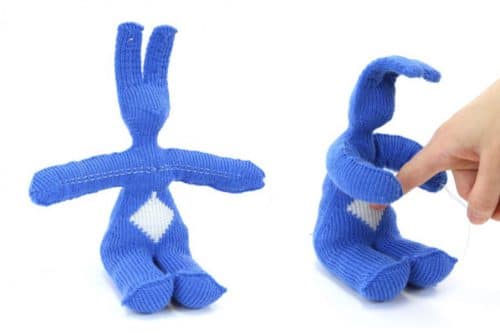Researchers have used computer-controlled knitting machines to create soft toys and other knitted objects powered by tendons. They believe their approach may one day be used to cheaply manufacture soft robots and wearable technologies.
Software developed by laboratories Morphing Matter Lab ו– Dev Lab At the Institute for Humanity-A Carnegie Mellon University machine allows knitting machines to produce objects in desired shapes when the tendons are already embedded in the objects. From here you can already fill them with filler material and connect the tendons to the motors, As needed.

Credit: Carnegie Mellon University
Leah Albo (Lea Albaugh) The doctoral student who led the research, Developed the techniques of assimilating the tendons and explored the aforementioned design space to create two-form lampshades, Stuffed dolls that hug when you press their stomachs, And even a sweater with a sleeve that moves by itself. Although these are objects that look more like whims, They demonstrate capabilities that may have serious practical implications, such as soft robots.
Albo noted that "Soft robotics is a growing field. The idea is to build robots from materials that do not endanger people, Therefore it will be very difficult to hurt someone. Soft powered components are components that would be cheap to produce on industrial knitting machines.
Elvo added that "there are so many soft objects in my life today-our day, And this technology can add heating capabilities to a large part of them. A garment can be part of a personal information system. Your sweater for example can tap your shoulder to get your attention. The fabric of the chair can be used as a tactile interface. Backpacks may be able to open themselves.
Elvo and the researchers who worked with her, Faculty members at the Institute for Human Development-Referred to(HCII), Scott Hudson and Lining Yao, Present their research in CHI 2019, The Institute for Human Factors in Computerized Systems of the Computing Society (Association for Computing Machinery) Between the-4 ל-9 May in Glasgow, Scotland.
Computerized knitting machines are a technology that is widely used, But they require careful programming for each garment. The current study builds on a previous study by Carnegie University-A hotel in the automation of the process, which will allow mass production knitting machines to create unique designs tailored for certain purposes.
"This is a very convenient route for producing knitted powered objects" Yao said, Professors company b- HCII. She noted that other researchers have also experimented with powered fabric objects, But always encountered the task of adding tendons to the finished objects, A task that took them a lot of time. Embedding the tendons in the material as part of the process saves time and effort, and improves the accuracy in operation.
The researchers are developing methods to implement horizontal tendon paths, Vertical, and diagonal in sheets and fabric tubes. They showed that the shape of the cloth, In combination with the tendon path, can create a variety of movement capabilities. including bends a-symmetrical, and curved bends. The stiffness of the objects can be controlled by filling them with different materials, such as materials available to hobbyists.
Different materials can be used for tendons, Includes polyester wrapped threads, Silk wool, and nylon thread.
In addition to the operation of the objects, The same methods can be used to add sensors to objects. By connecting sensors to each tendon it is possible, for example, to know in which direction the object is bent or folded. The researchers showed that by knitting with conductive wool they could create contact surfaces, and strain sensors to measure the strain rate of the material.
Albo says XNUMXD printing is used to create powered objects and components tailored for specific purposes, Although the materials are mostly hard materials. Computer controlled knitting has the potential to expand capabilities and create more people-friendly products.
she added - "I believe that there is empowerment in the use of materials that people already associate with convenience".
The National Institute of Science (National Science Foundation) Supported part of the research project.
To the news of the researchers

One response
You can see that an effort was made in choosing the terms, but the article is not readable enough.